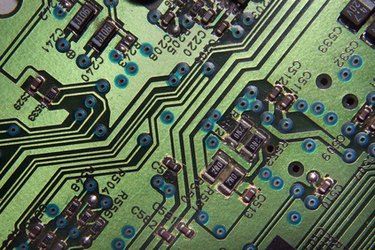
Circuit boards are found in a variety of electronic devices, gaming systems and computers. They hold microchips and cards, as well as plug into processors and power supplies. Cleaning a circuit board with baking soda is done to remove corrosion from the board and is not required for normal cleaning. Corrosion on circuit boards is usually caused by exposure to salt air or acid leaks from attached batteries. The mild abrasive qualities of the baking soda remove the corrosion without damaging the board.
Step 1
Detach all cables from the circuit board and pull out any chips inserted into it. Take note of where each one goes so that they can be properly reinserted after cleaning.
Video of the Day
Step 2
Pour a quarter-cup of baking soda into a small bowl and add 1 to 2 tablespoons of water until the mixture forms a thick paste.
Step 3
Insert a toothbrush into the baking soda paste and apply it onto the corroded parts of the circuit board. Scrub the circuit board gently with the toothbrush to loosen some of the corrosion.
Step 4
Allow the paste mixture to sit on the circuit board for 20 to 30 minutes. The paste mixture will dry during this time, which is normal.
Step 5
Rinse the circuit board off in clean water to remove all traces of the baking soda.
Step 6
Spray the entire surface of the circuit board with a standard household cleaner that does not contain phosphates. Allow the cleaner to sit for 10 to 15 seconds, then scrub the surface of the circuit board with the toothbrush. You don't need to scrub very hard, since you already cleaned it once with the toothbrush.
Step 7
Rinse the circuit board again in clean tap water and dry the board using a lint-free towel. Use a blotting motion when drying so as not to damage any of the small components.
Step 8
Preheat an oven to 170 degrees, then turn it off and place the circuit board inside. Allow the board to remain in the oven for two to three hours to remove all moisture.
Step 9
Reinsert all chips into the circuit board and reattach all cables.
Video of the Day